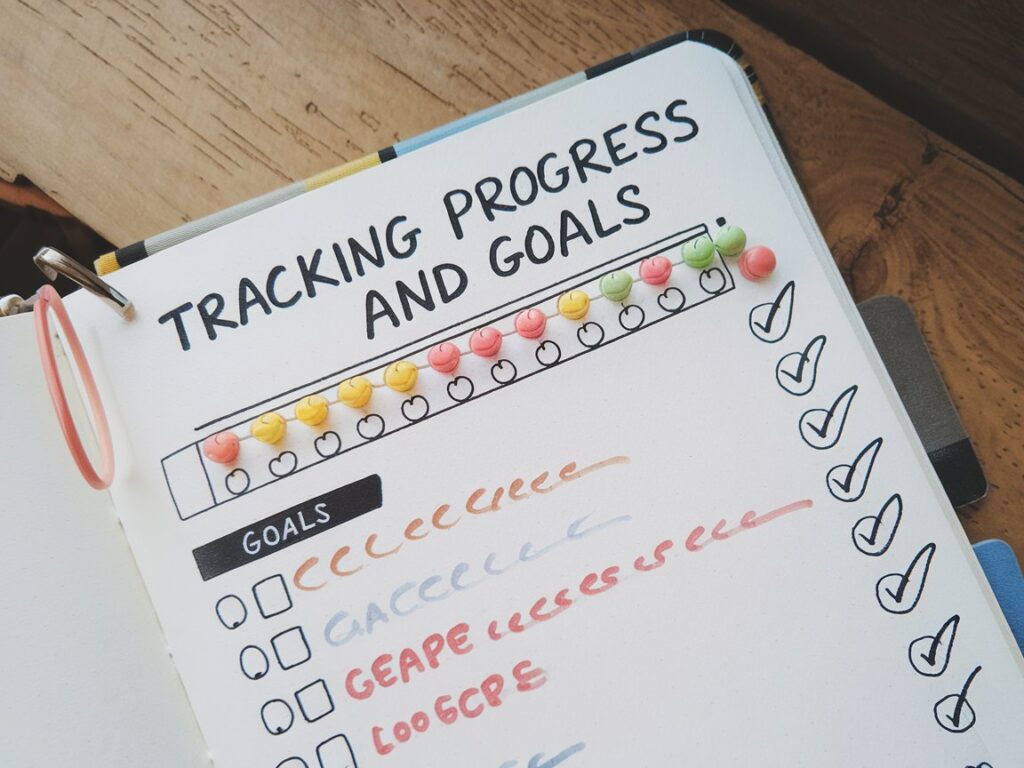In today’s fast-paced world, finding time for oneself can feel like an impossible task. However, incorporating a morning journal routine into your daily life can provide a space for reflection and self-growth.
Many individuals have discovered the power of starting their day with a pen and paper at hand. It’s not just about writing; it’s about creating clarity and intention for the hours ahead.
This practice can transform not only how you view your day but also how you approach your goals, especially when it comes to goal setting and morning planning. Here are some benefits that morning journaling offers:
- Enhances mental clarity
- Boosts productivity
- Helps in reflecting on past experiences
As we delve deeper into this topic, you’ll see how morning journaling can easily become a vital part of your daily routine. So, grab your favorite notebook, and let’s explore its incredible advantages together!

Benefits of Morning Journaling
Starting your day with a morning journal routine not only sets a positive tone but also brings about remarkable benefits that can influence your overall well-being. Let’s dive into two key advantages: mental clarity and increased productivity.
Mental Clarity
One of the most profound benefits of morning journaling is mental clarity. When you take a few moments to write, you free your mind from clutter, allowing thoughts and feelings to surface. This practice helps to:
- Organize your thoughts
- Identify your priorities
- Release emotions that may weigh you down
For example, the act of writing down worries or uncertainties often turns into an opportunity for clarity, making challenges seem more manageable.
Increased Productivity
In addition to fostering mental clarity, journaling in the morning can significantly enhance productivity. When you set aside time to outline your day, you are more likely to stay focused on your tasks. Here are a few ways journaling boosts productivity:
- Establishes daily goals and intentions
- Helps identify potential distractions
- Encourages accountability to your plans
When one morning, I wrote down my goals for the week, I noticed I accomplished tasks faster and with greater focus. It’s amazing how a simple habit can lead to such impactful changes!
By dedicating time to journal, you’re not just planning your day; you’re setting yourself up for success.

How to Start a Morning Journal
Now that you understand the benefits of morning journaling, the next step is to get started. Creating a morning journal routine doesn’t have to be overwhelming. With a few simple steps, you can incorporate this beneficial practice into your daily life. Here’s how to kick things off effectively.
Choose the Right Journal
Selecting a journal that resonates with you can make all the difference. Whether it’s a simple notebook or a beautifully bound journal, your choice can inspire creativity. Consider the following when choosing your journal:
- Size: Opt for a journal that fits your lifestyle. A small notebook can easily travel with you, while a larger one provides more space for writing.
- Design: Choose one that makes you feel excited to write. Whether it’s colorful, textured, or minimalist, find something that sparks joy.
- Guided or Blank Pages: If you’re not sure where to start, a guided journal with prompts can be very helpful. Just blank pages? Perfect for those who like to express freely.
When I started journaling, I chose a vibrant watercolor journal that inspired me to write every morning. It made the process feel more enjoyable and personal.
Set Aside Time
Establishing time for your morning journal is critical to making it a habit. Here are a few tips to carve out your journaling time:
- Morning Ritual: Link your journaling to another part of your morning routine, like having coffee or enjoying breakfast. This connection will make it easier to remember.
- Short Time Frame: Start with just 5-10 minutes. Even a short period can lead to meaningful insights and reflections.
- Consistency: Try to write at the same time each day. Consistency builds a habit, making it more likely that your journaling will stick.
For example, I reserve the first 10 minutes of my day right after I wake up. This dedicated time has become a cherished part of my morning, allowing me to focus my thoughts before diving into daily responsibilities.
By choosing the right journal and setting aside time, you’ll be well on your way to creating a fulfilling morning journaling experience.

Prompts for Morning Journaling
As you settle into your morning journal routine, it’s helpful to have prompts to guide your writing. These prompts can spark creativity, reflection, and intention-setting for the day ahead.
Here are two effective prompts that can enhance your journaling experience: a gratitude list and daily goals.
Gratitude List
Starting your day by writing a gratitude list can shift your mindset from worry to appreciation. Focusing on what you’re thankful for helps you build a positive outlook. To create an impactful gratitude list, consider these tips:
- Be Specific: Instead of just listing “family,” you might write, “I’m grateful for my sister’s support during difficult times.”
- Include Small Joys: Recognizing simple things like a warm cup of coffee or a beautiful sunrise can enhance your mood.
Reflecting on what you appreciate can provide a profound sense of connection and joy. One morning, I wrote about the comfort of my cozy blanket. That small detail set a positive tone for my entire day!
Daily Goals
Setting daily goals in your journal can transform how you approach your tasks. By outlining what you want to achieve, you create a sense of purpose. Here’s how to effectively set daily goals:
- Keep Them Simple: Aim for 2-5 achievable goals. For instance, “Finish writing the report” or “Take a 30-minute walk.”
- Prioritize: Identify the most crucial tasks by marking them or writing them first. This helps clarify what needs immediate attention.
Personally, I often write my goals for the day alongside my gratitude list. Having this balance reminds me of both what I value and what I aim to accomplish.
By integrating a gratitude list and daily goals into your morning journaling, you’ll cultivate a practice that encourages positivity and productivity in your everyday life.

Creating a Daily Routine with Journaling
Incorporating journaling into your daily routine can deepen your self-awareness and enhance your ability to set goals.
By reflecting on the previous day and setting intentions for the current one, you create a meaningful ritual that cultivates both mindfulness and purpose. Let’s explore how these practices can benefit your overall experience.
Reflecting on Yesterday
Before diving into the new day, it’s important to take a moment to reflect on yesterday. This act can help you understand your experiences more clearly and learn from them. Here are some reflective prompts to consider:
- What went well yesterday? Identify your achievements, no matter how small.
- What could have been improved? Think about challenges you faced and how to handle them better in the future.
- What did I learn? Acknowledge lessons that emerged, whether from successes or setbacks.
I often take a minute to write down one memorable moment from the day before. Just yesterday, I noted how a casual conversation with a friend brightened my spirits. Recognizing these moments can foster gratitude and awareness.
Setting Intentions for the Day
After reflecting, it’s time to set your intentions for the day ahead. This practice clarifies your focus and helps you align your actions with your values. Consider these tips for effective intention-setting:
- Be Clear and Specific: Instead of vague intentions like “be productive,” try “complete the project draft by noon.”
- Align with Your Values: Choose intentions that resonate with your core beliefs and priorities, such as “practice kindness” or “maintain a positive mindset.”
- Visualize Success: Picture achieving your intentions. This visualization can motivate you throughout the day.
One morning, I decided to focus on mindfulness, reminding myself to take things slow and appreciate each moment. As I went through my day, that simple intention kept me grounded and focused.
By integrating reflection and intention-setting into your daily journaling routine, you cultivate a powerful practice that enriches both your mind and spirit.

Incorporating Mindfulness in Your Morning Journal
As you develop your morning journal routine, incorporating mindfulness can deepen your practice and enhance your overall well-being.
Two effective methods for fostering mindfulness within your journaling are practicing mindful breathing exercises and using positive affirmations.
These techniques can transform your writing sessions into moments of clarity and reflection.
Mindful Breathing Exercises
Starting your journaling session with mindful breathing can center your thoughts and help clear your mind. Even just a few deep breaths can significantly impact your focus and clarity. Here’s how to do it:
- Find a Comfortable Position: Sit comfortably in a quiet space where you won’t be disturbed.
- Inhale Deeply: Breathe in through your nose for a count of four, allowing your belly to rise.
- Hold and Exhale: Hold your breath for a count of four, then exhale slowly through your mouth for a count of six.
After incorporating this exercise into my own routine, I noticed I approached my journaling with a sense of calm and openness.
It created a mental space that allowed my thoughts to flow more freely, resulting in more meaningful reflections.
Positive Affirmations
Another powerful addition to your morning journal is the practice of writing positive affirmations. Affirmations are positive statements that encourage motivation and promote self-belief. Here’s how to implement them:
- Choose Affirmations: Write down 3-5 affirmations that resonate with you. Examples might include: “I am capable of achieving my goals” or “I embrace challenges as opportunities.”
- Repeat and Reflect: Read them aloud while reflecting on why they are important to you. Consider how they can shape your intentions for the day.
When I began incorporating affirmations into my journaling, the shift in my mindset was profound. For instance, affirming, “I am worthy of love and respect,” helped me tackle challenging situations with confidence throughout my day.
By adding mindful breathing exercises and positive affirmations, your morning journaling can evolve into a powerful practice that fosters mindfulness and self-empowerment.

Tracking Progress and Goals
Being effective in your morning journal routine also involves tracking your progress and setting clear goals. This can provide a sense of accountability and motivation as you work towards achieving what you desire.
Two essential components of this tracking process include using a habit tracker and practicing effective goal setting.
Habit Tracker
A habit tracker is a visual tool that helps you monitor your daily habits and routines. By using this method, you gain insights into your behaviors and can identify patterns over time. Here’s how to create a habit tracker:
- Choose Your Habits: Select a few habits you want to track, such as water intake, exercise, or journaling.
- Create a Table: Draw a simple table with days of the week listed horizontally and your chosen habits vertically.
- Mark Your Progress: At the end of each day, fill in your tracker to show whether you completed your habits.
When I started using a habit tracker, I noticed how often I let certain beneficial practices slip. Seeing my progress visually each week encouraged me to stay committed. This simple tool turned accountability into fun!
Goal Setting
Goal setting is a crucial aspect of maintaining focus and direction in your life. Here are some effective strategies to set your goals within your journaling practice:
- Be Specific: Instead of saying, “I want to get fit,” try “I will exercise for 30 minutes at least three times a week.”
- Set Time Frames: Assign deadlines to your goals. This helps break down larger objectives into manageable tasks.
- Review and Adjust: Regularly revisit your goals. If something isn’t working, be open to making adjustments as necessary.
One month, I set a personal goal to read two books. By breaking that down into a few chapters each week, I found I was more likely to stay on track.
Tracking your progress and setting clear goals can create a sense of purpose and accomplishment that enriches your morning journaling practice and your life overall.

Troubleshooting Common Challenges
As you engage in your morning journal routine, you may encounter a few challenges along the way. Two common obstacles are the feeling of lacking time and experiencing writer’s block.
Understanding how to overcome these hurdles can enhance your journaling experience, making it more enjoyable and sustainable.
Lack of Time
In today’s busy world, finding time for journaling can seem daunting. However, you can still make it work with these strategies:
- Set a Timer: Dedicate a short window of 5-10 minutes. Setting a timer makes it easier to commit without feeling overwhelmed.
- Journal in Segments: If you have a packed schedule, try writing a few lines whenever you get the chance, such as during your commute or lunch break.
- Prioritize Your Practice: Treat your journaling as a crucial part of self-care. By prioritizing it, you’ll naturally carve out time for it.
I remember a particularly hectic week when I managed to journal just before bed. Switching to this evening routine gave me the flexibility I needed without sacrificing the practice altogether.
Writer’s Block
Experiencing writer’s block can be frustrating, particularly when you’re eager to write. Here are some helpful techniques to get past this challenge:
- Use Prompts: Keep a list of prompts handy to inspire your writing when you’re stuck. Questions like “What made me smile today?” can spark reflections.
- Free Write: Allow yourself to write without judgment for a set time. Just let your thoughts flow onto the page without worrying about grammar or structure.
- Change Your Environment: Sometimes, a change of scenery can refresh your mind. Try journaling outside or in a different room to boost creativity.
I often face writer’s block after a long day, but using prompts has helped me find direction. Sticking to these techniques allows me to maintain my journaling practice, ensuring that I work through challenges effectively.
By addressing these common challenges—lack of time and writer’s block—your morning journaling can flourish, bringing depth and clarity to your daily life.

Making Journaling a Habit
Transforming your morning journal routine into a lasting habit requires intentionality and consistency.
By establishing a solid routine and finding ways to stay consistent, you can ensure that journaling becomes a meaningful part of your daily life.
Let’s delve into some practical strategies to help you create this rewarding practice.
Establishing a Routine
Creating a journaling routine is essential for making it a habit. Here are some steps to help you establish and solidify your routine:
- Choose a Consistent Time: Pick a specific time each day, whether it’s first thing in the morning or just before bedtime.
- Pair with Another Activity: Connect journaling to another daily habit, like your morning coffee or evening wind-down. This pairing will help remind you to write.
- Create a Comfortable Space: Designate a cozy spot for journaling. Whether it’s a quiet corner of your home or a favorite chair, having a dedicated space can enhance your experience.
For instance, I began journaling while sipping my morning coffee. This simple habit made it easier to get into the right mindset for writing and provided a comforting routine to start my day.
Staying Consistent
Consistency is key to solidifying your journaling practice. Here are several tips to help you stay on track:
- Set Realistic Goals: Start with small, achievable goals. Even writing just three sentences is better than nothing. This approach builds confidence and reduces pressure.
- Track Your Progress: Use a habit tracker or a simple checklist to mark off your journaling days. Seeing your progress can be incredibly motivating.
- Be Kind to Yourself: If you miss a day, don’t dwell on it. Accept that it’s okay to take breaks. Just pick up your journal again the next day.
I’ve learned that maintaining consistency doesn’t mean being perfect. On days when I forget, I simply start fresh without guilt.
By establishing a routine and staying consistent, journaling can evolve from a chore into a rewarding practice that enriches your life and enhances your personal growth.

Key Takeaways
- Embrace Flexibility: Remember, journaling is your personal journey. Feel free to adjust your routine and prompts as needed.
- Celebrate Small Wins: Every entry is a step towards personal growth. Acknowledge your commitment to this practice.
- Keep It Simple: Focus on what feels right for you. Whether it’s jotting down gratitude or tracking progress, find what resonates.
As we wrap up our exploration of morning journaling, it’s clear that this practice offers numerous benefits for mental clarity, productivity, and overall well-being.
By integrating journaling into your daily routine, you’re not just committing words to paper; you’re making time for self-reflection, growth, and intention-setting.
Personally, my daily journaling ritual has become a welcoming space for thoughts and reflections that help shape my day.
By making it a habit, I’ve grown not only in my ability to express myself but also in my understanding of my goals and emotions. So grab that journal, and let your journey begin!
Read them now about morning routine hacks:




